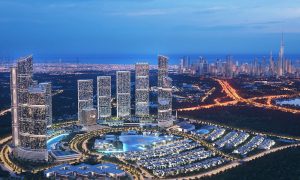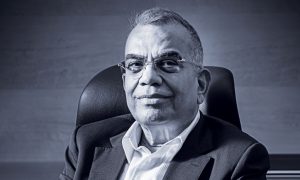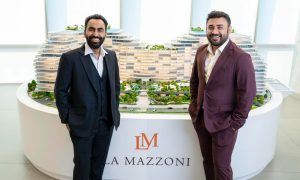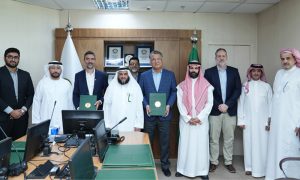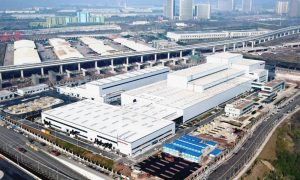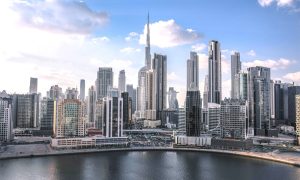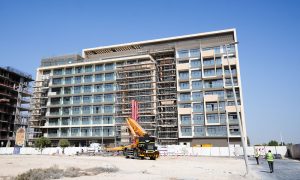Project profile: Sobha Hartland, Dubai
Big Project ME visits Sobha Hartland to see how developer Sobha Group is controlling every aspect of construction and delivery of the mammoth project

In summer 2017, the Sobha Group announced that Phase 1 of Sobha Hartland was 90% sold out and on track for completion in December 2017, with Buildings 1 and 4 of Hartland Greens – part of Phase 1 – completed, and Phases 2 and 4 set for completion in December 2018 and October 2019 respectively.
Most recently, the developer announced the launch of Building 5 of its Hartland Aflux neighbourhood within the Hartland Greens development. The 12-storey property is being developed as part of Phase 3. In addition, Gardenia Villas were also recently launched as part of Phase 2, creating a hive of bustling activity all across the project site.
With work in full swing, Big Project ME was invited to tour the development and get up to speed with the progress of some of the key projects currently being built – the Villas Phase 1, townhouses and Greens Phase 1.
“If you talk about Hartland, it’s a total of 743,224sqm and we’ve launched three key projects – the apartments, the villas and the townhouses. These three projects are the key projects in the residential market that we’re catering to now,” says Francis Alfred, CEO of Sobha Group.
“The construction is underway for the villas, townhouses and apartments, and the first project that will be handed over to customers will be the apartments. Our schedule is for Q1 2018, and we’ll have the first deliveries by then. In Q2 we’ll be delivering the villas, and by Q4 we’ll deliver the townhouses.
“At the moment, construction is going at the right pace. It’s a greenfield project, so that includes everything: infrastructure, the buildings, the landscape. Everything is underway. Our model of construction is that of backward integration. This is something that helps us deliver things as per the schedule,” he explains.
In pictures: Site visit to Sobha Hartland project, Dubai
Rather than relying on an external contractor or consultant, Sobha Group looks to keep everything in-house, using its own contractors, architects and workforce. This approach extends to all its projects, and Hartland is no exception.
Alfred asserts that this gives the developer a significant advantage, particularly in terms of keeping to the delivery schedule, as it doesn’t depend on the contractor’s schedule or other external delays.
“Construction is in full swing. There are 1,500-1,600 workers on-site at the moment. It’s going to ramp up. By mid-next year, there’s going to be around 3,000 people. Given today’s mechanised world of construction, you actually don’t want to have a large number of workers. You’d rather look at mechanisation, and we always look into how we can use technology to our advantage.”
To this end, the group has set up a Quality and Technology department mandated to looking into new technologies and products that will help improve and maintain quality, Alfred says. He points out one example, where the company adopted a technology from Germany that has substantially reduced the labour used for laying reinforcement.
Returning to the development, he says some areas of the project will be ready for handover within the next six months. Design is now in place for the next phases already announced, he adds, pointing out that design is completed for Phase 2 and 3 apartments and Phase 2 villas, and that construction has started on Phase 2 apartments, with construction on Phase 3 apartments imminent.
“We’re quite bullish on what things are happening. We’re getting a good response from the market. The recent project that we launched a couple months ago, we’re just going ahead and starting the construction. Phase 3 is also starting. The new Gardenia Villas should also be starting the last quarter of this year, so things are going well,” Alfred says, adding that by the end of next year, there could be as many as 4,000 people doing works alone in Hartland.
In pictures: Site visit to Sobha Hartland project, Dubai
Of course, having so many people involved on multiple projects makes managing worker health and safety even more difficult. However, Alfred insists that Sobha’s backwards integrated model comes into play again here, giving the developer greater control and accountability across the board.
“We want to make sure that what we do is of very high quality, and that there is no reason for it to be a lesser product. We want it to be the ultimate product, and to do that, we understood that we needed to have our own workforce. When you have so much of an internal workforce, it comes with a lot of responsibility in terms of health and safety, with respect to skills training and all of that.
“What we do is assess the people who come into our projects. There’s a very stringent filtering out of people, a screening of people when they’re recruited. Once they’re recruited, we then assess them and understand their skill sets to see what they’re lacking. We then give them specific training on skills, on health and safety requirements, and there’s also periodic training in place.
“On a very global level, this is what we do. But also on a micro level, we have what is called a daily quality talk, a daily safety talk – this is done for every worker and technician in the company, they get training every day on quality and safety. It’s all about the training and imparting the knowledge and monitoring the process. We have a monitoring process that’s very stringent, in fact we have an audit function, which is a team employed by the client (the development arm of the group),” he says.
The auditors are a team from Germany and Alfred explains that their job is to ensure that there’s no compromise on all the requirements for the project.
“With the training, we get the level of people upgraded to the right level, but the audit ensures that there is no complacency or dilution. It’s all about putting in place the right processes. This is a well-proven process for Sobha. We’ve mastered it over the last 40 years, and we know how it works and will continue to work.”
In pictures: Site visit to Sobha Hartland project, Dubai
Furthermore, Alfred explains that keeping everything in-house allows the developer and project teams to manage coordination and logistics on-site more efficiently. Working with in-house companies has lessened the time taken on projects, while also ensuring that there are fewer clashes and reworks.
“What happens is that right at the design stage, we do a lot of coordination, a lot of workshops and brainstorming sessions, where we ensure that everything is coordinated on the drawings. It’s not like the contractor comes in and gives us 10 issues which the designer must fix; most of the time it has been sorted out at the drawing board itself.
“Because we’ve got these in-house companies, the participation is much more engaging. It’s driven by one goal and one objective – to ensure that there is a very high-quality, value-based product created. So it’s been much easier for us, as compared to the conventional model.”
Logistically, each project team is tasked with managing its own time schedule, requirements and so on. However, there is a logistics team managed by the main contractor whose job is to look at logistics management, central safety management and the security of the sites, Alfred explains.
“When you have so much construction happening, it’s important to have the right controls in place. We have a system in place. We’ve been doing this on the other master developments also. We have a central system that’s all monitored by CCTV cameras. In fact, everything is quite sophisticated – if I’m sitting in my office, I can see what’s happening with the project. We have enough systems in place [to monitor the project].”
This should come as no surprise, he says – Sobha Group has always embraced the use of technology, with the group’s R&D team tasked with finding products and technologies that will improve performance and efficiency both during and after the construction phase.
“We also use BIM – it’s become almost a requirement for this scale of projects. Without it, it becomes very difficult to manage. Our design studio is BIM-enabled. We have more than 70-75 people employed in the design studio, and there is a BIM team who works on and produces all the models and plans.”
Finally, asked what impact he expects these projects to have on the market, Alfred is quick to point out that there has been a strong response already. He asserts that the launch of Phase 3 for the apartments and Phase 2 for the villas is an indication that the market is ready to back Sobha Group’s investment and boldness in development.
“We’ve put up some good show villas for customers to see, and the reactions have been very good. People have been extremely happy with the design, the quality of the interior space, the construction. We feel that this has been enabled through a very distinctive model. We know what we’re creating, and we control every aspect of its creation.
“Whatever we’ve launched, be it Phase 1, Phase 2 or Phase 3, things are moving in the right direction and there’s been a good customer response. We’re a good brand that’s been in place for a long time. We have been getting a lot of referral customers, and people clearly feel that Hartland is not just a building or a development, but a community,” he concludes proudly.
In pictures: Site visit to Sobha Hartland project, Dubai
